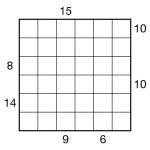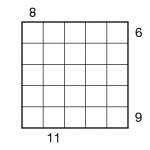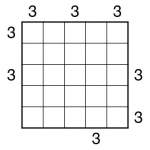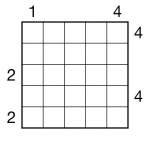Archive for May, 2013
Sum Skyscraper puzzles
May 14th
Following-up yesterday’s Skyscraper puzzles, I thought I’d post a couple of Sum Skyscraper variant puzzles.
Sum Skyscraper puzzles are very similar to Skyscraper puzzles, so no number can repeat in any row or column and external ’skyscraper’ clues reveal information about the numbers in the main grid. In 5×5 puzzles place 1-5, and in 6×6 puzzles place 1-6.
Each number in the completed grid represents a building of that many storeys, and place the buildings in such a way that each given number outside the grid represents the sum of the number of buildings that can be seen from that point, looking only at that number’s row or column. A building with a higher value always obscures a building with a lower value, while a building with a lower value never obscures a building with a higher value. So the clue ‘6′ in a 5×5 puzzle would indicate that the buildings ‘1′ and ‘5′ can be seen (’5′ is always visible in 5×5 puzzles), so the solution to a row might be 15234.
Skyscraper puzzles
May 13th
I haven’t posted here for a while, but to celebrate the advent of reduced-clue skyscraper puzzles on PuzzleMix.com earlier today I thought I’d post a few Skyscraper puzzles here.
Skyscraper puzzles combine the no-repeat row and column constraints of sudoku with novel additional clues. In these 5×5 puzzles, place the numbers 1-5 once each into every row and column. Each number in the completed grid represents a building of that many storeys.
Place the buildings in such a way that each given number outside the grid represents the number of buildings that can be seen from that point, looking only at that number’s row or column. A building with a higher value always obscures a building with a lower value, while a building with a lower value never obscures a building with a higher value.





Recent Comments